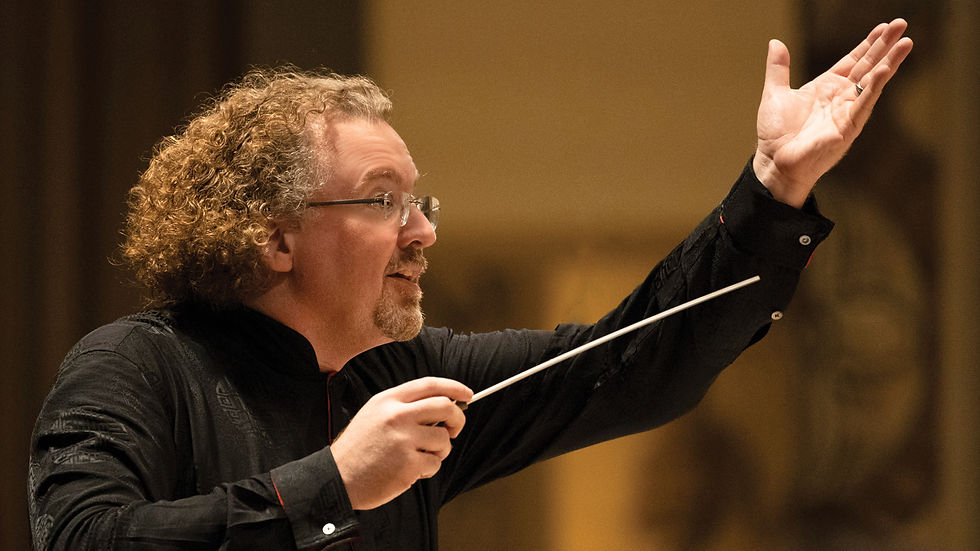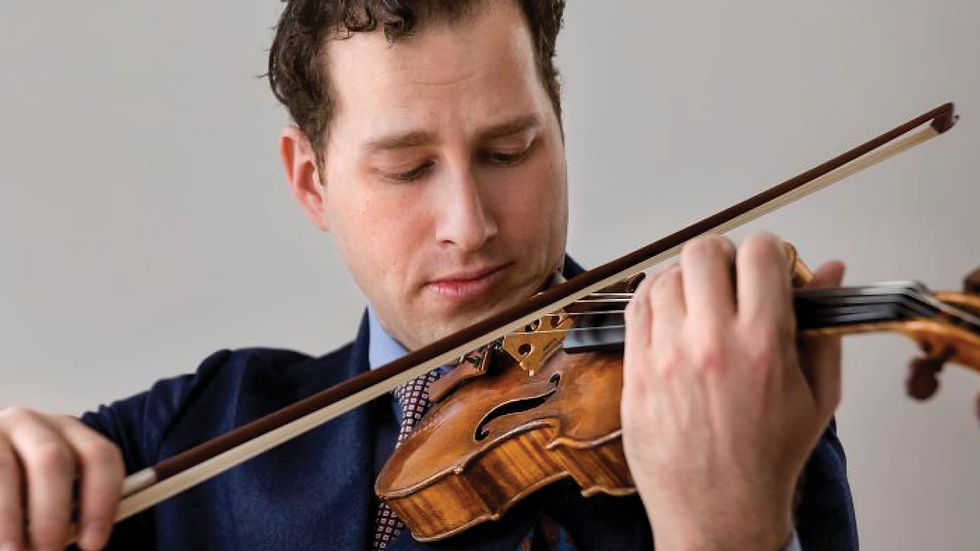Program Notes: Fliter Plays Schumann (October 29-30, 2021)
- SLSO
- Oct 25, 2021
- 5 min read
Program
Nikolaj Szeps-Znaider, conductor
Ingrid Fliter, piano
Luctus Profugis: Elegy for the Displaced (2016)
Robert Schumann
Piano Concerto in A Minor (1841)
Allegro affetuoso
Intermezzo: Andantino grazioso
Allegro vivace
Ingrid Fliter, piano
Bedřich Smetana
Selections from Má vlast (1874-1879)
Vyšehrad (The High Castle)
Vltava (The Moldau)
Šárka (Maiden Warrior)
Z českých luhův a hájův (From Bohemia’s Woods and Fields)
Program Notes
By Caitlin Custer
This is a program about place, about home. Karim Al-Zand laments the loss of homeland for thousands of refugees, and Bedřich Smetana captures his beloved Bohemia in his vivid collection of musical portraits. After years spent fighting for it, Robert Schumann creates a musical and family home with his partner.

Luctus Profugis: Elegy for the Displaced
Karim Al-Zand
Born 1970, Tunis, Tunisa
Karim Al-Zand casts a wide net to find inspiration. His catalog includes pieces inspired by dance, poetry, visual artwork, a children’s book, even a ringtone. He finds ideas in heavier stories, too: war, the plight of prisoners, and various political crises.
Inspirations converge in Luctus Profugis: Elegy for the Displaced. The word “profugis”—meaning “refugees”—nods to Virgil’s The Aeneid, where a legendary warrior escapes the Trojan War across the Mediterranean. In modern times, the same waters have posed peril and death to thousands of refugees fleeing Syria and other areas of conflict. The same waters connect Al-Zand to these stories: though he’s spent most of his life in Canada and the U.S., his birthplace, Tunis, is on the southern coast of the Mediterranean.
“In Luctus Profugis,” Al-Zand writes, “the percussionist at the heart of the ensemble plays a simple three-note motive that repeats for the duration of the piece.” It’s the very first thing you’ll hear, before strings layer in. The percussion’s “persistence symbolizes the refugees’ journey, their tenacity, courage, and resilience.”
Al-Zand has said that he “usually writes with a goal in mind,” and that he hopes Luctus Profugis is “not only an elegy, but also a call to action.”
First performance: October 16, 2016, by the Kinetic Ensemble, in Houston, Texas First SLSO performance: This weekend’s concerts Instrumentation: vibraphone, strings Approximate duration: 6 minutes

Piano Concerto
Robert Schumann
Born June 8, 1810, Zwickau, Germany
Died July 29, 1856, Endenich, Germany
In the 1840s, things were looking up for the Schumanns. Robert and Clara had married after years of courtship and a lengthy legal battle with her father. Both were ambitious, cultivating music careers: Clara as a concert pianist, Robert as a composer and music journalist.
Robert entered a prolific period of composition as his marriage and family flourished. He left his previously piano-focused work behind, writing dozens of songs, several chamber works, and two symphonies. He also began to grapple with episodes of mania and depression.
Robert loved the piano and had wanted to make a career as a performer. A hand injury put an end to that dream, and in its place came the idea to write a piano concerto. It started as a one-movement Fantasy for piano and orchestra in 1841. After several revisions and still no interest from publishers, Clara encouraged him to expand the Fantasy into a full-fledged concerto. It was an instant hit at its 1845 premiere with Clara as the soloist and has been a concert mainstay ever since—included on SLSO programs every few years since 1913.
I. Allegro affettuoso (Brisk, with feeling): Anyone who’s felt that first “spark” of a
relationship will recognize this electric start. Tender moments are shared on-again, off-
again, swept up in heart-thumping romance.
II. Intermezzo—Andantino grazioso (Interlude—moderate and graceful): Blissful, serene
countryside.
III. Allegro vivace (fast and lively): That first spark has grown into a healthy flame, warming,
challenging, and triumphing.
“Schuman was a poet,” pianist Ingrid Fliter has said, “someone who was always seeking inside of himself. Even though this concerto might have been thought of as a piece to show off…he couldn’t help his own nature. He came back to his inner soul…. Schumann is not afraid of showing fragility, and weakness, which is something not very popular in our modern world. Quite important as a lesson to be learned…”
First performance: December 4, 1845, in Dresden, Germany, Ferdinand Hiller conducting, with Clara Schumann as soloist
First SLSO performance: January 24, 1913, Max Zach conducting, with Max Pauer as soloist Most recent SLSO performance: October 24, 2015, John Storgårds conducting, with Lars Vogt as soloist Instrumentation: piano soloist, 2 flutes, 2 oboes, 2 clarinets, 2 bassoons, 2 horns, 2 trumpets, timpani, strings Approximate duration: 31 minutes

Selections from Má vlast
Bedřich Smetana
Born March 2, 1824, Litomyšl, Czech Republic
Died May 12, 1884, Prague, Czech Republic
Bedřich Smetana struggled to find and keep a sense of home. He bounced between country and city as a child, battling homesickness. Eventually he set his sights on Prague, the capital city of Bohemia, modern-day Czech Republic. A talented pianist, committed educator, and budding composer, he had ambitions to mirror W.A. Mozart or Franz Liszt.
When he arrived in Prague, the city responded with mixed messages. First it would champion him, then turn lukewarm. One moment he was too similar to Gustav Mahler or Hector Berlioz (according to the Schumanns), and the next he was not Czech enough. “A prophet is without honor in his own land,” he wrote.
But whatever cities and countries he explored, something always called him back to Prague, to Bohemia. “My home has rooted itself into my heart so much that only there do I find real contentment. It is to this that I will sacrifice myself.”
By his 50s, Smetana’s health was failing. He lost his hearing, and his second marriage was unhappy. He retreated to his daughter’s country home to focus on composing. With fresh air and idyllic landscape, he finished a project that captured his homeland in music: Má vlast. The work was dedicated to and premiered in Prague, the city he adored.
Má vlast was created piecemeal, as six individual tone poems. This concert will feature four of the six:
I. Vyšehrad (The High Castle): Harps lift morning fog to reveal a legendary riverside castle. Brass broaden the view and showcase the seat of power. Sneaky woodwinds and bustling strings tour the hallways. We reach the gilded rooms just as the castle falls into ruin, but the surrounding natural beauty remains.
II. Vltava (The Moldau): Walks along this river gave Smetana peace as his health deteriorated. Vltava “depicts the course of the river,” he wrote, “from its beginnings where two brooks join a stream, running through forests and meadows and a lovely countryside where merry feasts are celebrated; water-sprites dance in the moonlight; on nearby rocks can be seen the outline of ruined castles, proudly soaring into the sky. The river swirls through the St. John Rapids and flows in a broad stream towards Prague. It passes Vyšehrad rock and disappears majestically into the distance.”
III. Šárka (Maiden Warrior): This tune mixes military marches and lush romance. Inspired by The Maidens’ War, a Czech legend, we follow Šárka, lieutenant of a women’s uprising. Šárka ties herself to a tree to lure in a leader of the men’s army, who believes her act and falls in love with her. She serves him and his troops sleeping-potion-laced mead, then her warriors slay them.
IV. Z českých luhův a hájův (From Bohemia’s Woods and Fields): Originally written as the finale of Má vlast, this piece starts with an intimidating musical picture of the mighty Czech forests. What follows is a tour through mountain trails, sunny meadows, and folk festivals, full of unexpected turns.
First performance: November 5, 1882, in Prague, Bohemia, by the Prague Provisional Theatre Orchestra, Adolf Čech conducting First SLSO performance (Vyšehrad): December 30, 1910, Max Zach conducting Most recent SLSO performance (Šárka): March 3, 2018, Christian Arming conducting Instrumentation: 2 flutes, piccolo, 2 oboes, 2 clarinets, 2 bassoons, 4 horns, 2 trumpets, 3 trombones, tuba, timpani, percussion (bass drum, cymbals, triangle), 2 harps, strings Approximate duration: full work, 72 minutes; today’s selections, 45 minutes
Caitlin Custer is the SLSO's Communications Manager
Program Notes are sponsored by Washington University Physicians.




Comments